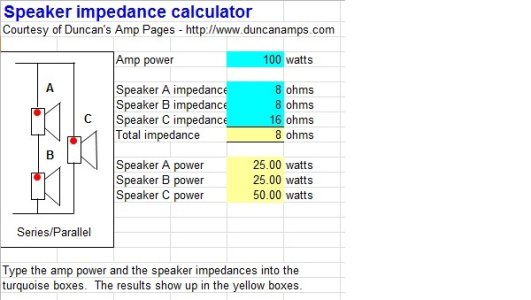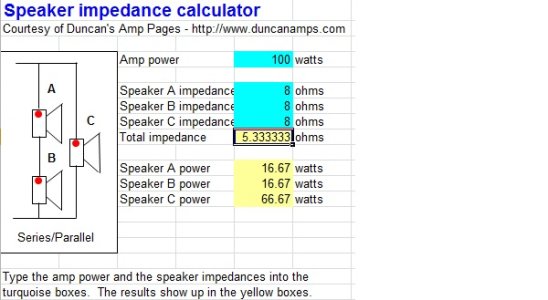You are using an out of date browser. It may not display this or other websites correctly.
You should upgrade or use an alternative browser.
You should upgrade or use an alternative browser.
50w Cab and 100w Head
- Thread starter Kais
- Start date
guitfiddle
firstlessonologist
Re: 50w Cab and 100w Head
Yes. If you don't go too loud, it might be ok, but the rule of thumb is to use twice the amount of speaker wattage as your amp puts out. Be careful!!
Yes. If you don't go too loud, it might be ok, but the rule of thumb is to use twice the amount of speaker wattage as your amp puts out. Be careful!!
Last edited:
Chickenwings
Alnico 6/8
Re: 50w Cab and 100w Head
yes.
two greenbacks is rated for 50 watts.
You will exceed their manufacturers specifications and run the risk of blowing them both.
yes.
two greenbacks is rated for 50 watts.
You will exceed their manufacturers specifications and run the risk of blowing them both.
allbutromeo
New member
Re: 50w Cab and 100w Head
I wouldn't risk it at more than bedroom volumes. WGS has some great options for very reasonable prices
I wouldn't risk it at more than bedroom volumes. WGS has some great options for very reasonable prices
Kais
New member
Re: 50w Cab and 100w Head
hmmm...please elaborate
in case you are goin to keep that cab for that head only, you can go for series/parallel circuit with power resistors to cope up with the extra wattage
hmmm...please elaborate
Ascension
Well-known member
Re: 50w Cab and 100w Head
Yep agree here with both. What will happen is the speakers will over heat and the voice coils will start bubbling in the coating if you push it. Keep the volume down until you can get some higher wattage speakers.
I second looking at WGS as I absolutely love the tones I'm getting with the WGS ET 90 and Retro 30 I have in my Zinky Velvet and Blackstar 1/12 cab right now.
By themselves both sound really good and both replaced Celestians but together they are awesome! The ET 90 replaced a heritage in the Velvet and the Retro bested both the stock 70/eighty and a older Brit built Vintage 30 in a head to head tone shoot out tone in the Blackstar.
Here is the set up running live and unmiced in a larger room.
I wouldn't risk it at more than bedroom volumes. WGS has some great options for very reasonable prices
Yep agree here with both. What will happen is the speakers will over heat and the voice coils will start bubbling in the coating if you push it. Keep the volume down until you can get some higher wattage speakers.
I second looking at WGS as I absolutely love the tones I'm getting with the WGS ET 90 and Retro 30 I have in my Zinky Velvet and Blackstar 1/12 cab right now.
By themselves both sound really good and both replaced Celestians but together they are awesome! The ET 90 replaced a heritage in the Velvet and the Retro bested both the stock 70/eighty and a older Brit built Vintage 30 in a head to head tone shoot out tone in the Blackstar.
Here is the set up running live and unmiced in a larger room.
Last edited:
koshikas
New member
Re: 50w Cab and 100w Head
i would love to, essentially it's about adding a DIY dummy load whilst having the cab in the mix allowing you to run the head at its full power. to do the elaboration i'll need to know how the 2x12 cab has its speakers wired. assuming its 8 ohmer greenbacks inside, is the cab impedance rated at 4 ohms or 16 ohms?
hmmm...please elaborate
i would love to, essentially it's about adding a DIY dummy load whilst having the cab in the mix allowing you to run the head at its full power. to do the elaboration i'll need to know how the 2x12 cab has its speakers wired. assuming its 8 ohmer greenbacks inside, is the cab impedance rated at 4 ohms or 16 ohms?
Kais
New member
Re: 50w Cab and 100w Head
yes the cab is at 16olms
i would love to, essentially it's about adding a DIY dummy load whilst having the cab in the mix allowing you to run the head at its full power. to do the elaboration i'll need to know how the 2x12 cab has its speakers wired. assuming its 8 ohmer greenbacks inside, is the cab impedance rated at 4 ohms or 16 ohms?
yes the cab is at 16olms
koshikas
New member
Re: 50w Cab and 100w Head
meaning that the two 8 ohmer greenbacks are in series, making the total impedance 16 ohms.
solution (1);
if you can put a 16 ohm power resistor (with 100W rating) in parallel with the cab you endup having total impedance of 8 ohms and the whole thing capable of handling 100W.

however heeding the aforementioned warnings;
the second solution would be;
put a 8 ohm power resistor (with 150W rating) in parallel with the cab now having total impedance of 5.33 ohms.

the second solution will require the head to have 4 ohm speaker/cab out. if the output power of the head is at 100W the speakers will only get a 16.67 watt load (well below its power rating) each while the power resistor will get 66.67 watts of load, meaning there is that tolerance for the head to go over 100W and still not cook the speakers in the process.
BTW the powers resistors would require heat sinks, and hence would require some sort of enclosure to fix them in.
yes the cab is at 16olms
meaning that the two 8 ohmer greenbacks are in series, making the total impedance 16 ohms.
solution (1);
if you can put a 16 ohm power resistor (with 100W rating) in parallel with the cab you endup having total impedance of 8 ohms and the whole thing capable of handling 100W.

however heeding the aforementioned warnings;
but the rule of thumb is to use twice the amount of speaker wattage as your amp puts out. Be careful!!
Yeah, considering your Marshall head really runs closer to 200w at full volume
the second solution would be;
put a 8 ohm power resistor (with 150W rating) in parallel with the cab now having total impedance of 5.33 ohms.

the second solution will require the head to have 4 ohm speaker/cab out. if the output power of the head is at 100W the speakers will only get a 16.67 watt load (well below its power rating) each while the power resistor will get 66.67 watts of load, meaning there is that tolerance for the head to go over 100W and still not cook the speakers in the process.
BTW the powers resistors would require heat sinks, and hence would require some sort of enclosure to fix them in.
koshikas
New member
Re: 50w Cab and 100w Head


Sent from my XT1033 using Tapatalk
you'll need those heat sinks used for power transistors, as for attachment you can use gud ole nut & bolt with some thermal paste. these are power resistors not those tiny crittersHow do you go about attaching the heat sinks to the resistors? I'm imagining some thermal paste and cheap old CPU heat sinks would probably work OK.


Sent from my XT1033 using Tapatalk
Last edited:
Kais
New member
Re: 50w Cab and 100w Head
oh awesome! so basically just create a dummy load with one of those golden resistors so the amp sends power there and just kinda vanishes, while a useable chunk of power goes to the actual speakers. Makes sense. Funny enough, I recently bought some of those resistors for my car's led system. Are you aware of any DIY guides for this? Very noob and obviously not familiar, step by step guide would be very helpful. Best part is this can be reversed right?
meaning that the two 8 ohmer greenbacks are in series, making the total impedance 16 ohms.
solution (1);
if you can put a 16 ohm power resistor (with 100W rating) in parallel with the cab you endup having total impedance of 8 ohms and the whole thing capable of handling 100W.
View attachment 61959
however heeding the aforementioned warnings;
the second solution would be;
put a 8 ohm power resistor (with 150W rating) in parallel with the cab now having total impedance of 5.33 ohms.
View attachment 61960
the second solution will require the head to have 4 ohm speaker/cab out. if the output power of the head is at 100W the speakers will only get a 16.67 watt load (well below its power rating) each while the power resistor will get 66.67 watts of load, meaning there is that tolerance for the head to go over 100W and still not cook the speakers in the process.
BTW the powers resistors would require heat sinks, and hence would require some sort of enclosure to fix them in.
you'll need those heat sinks used for power transistors, as for attachment you can use gud ole nut & bolt with some thermal paste. these are power resistors not those tiny critters


Sent from my XT1033 using Tapatalk
oh awesome! so basically just create a dummy load with one of those golden resistors so the amp sends power there and just kinda vanishes, while a useable chunk of power goes to the actual speakers. Makes sense. Funny enough, I recently bought some of those resistors for my car's led system. Are you aware of any DIY guides for this? Very noob and obviously not familiar, step by step guide would be very helpful. Best part is this can be reversed right?
Similar threads
- Replies
- 2
- Views
- 70
- Replies
- 11
- Views
- 126
- Replies
- 5
- Views
- 99
- Replies
- 26
- Views
- 338
